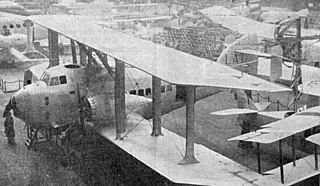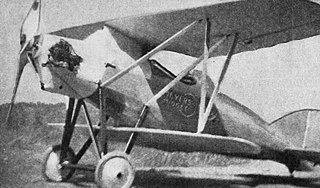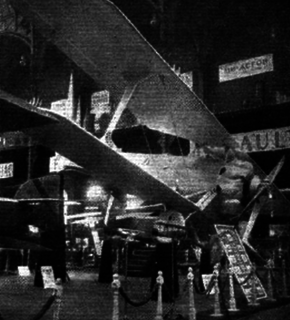
The Latécoère 4 was a three-engined, 15-passenger biplane built in France in the early 1920s. It proved difficult to fly and was discontinued, though a second machine was completed as the Latécoère 5 bomber.
The Hanriot HD.6 was a French two-seat fighter aircraft prototype, built towards the end of World War I though not flown until after the armistice with Germany. A biplane with an unusually narrow gap between upper and lower wings, powered by a single water-cooled radial engine, it did not enter production.

The Meyers Midget was a one-off small, low-powered, sporting single-seat sesquiplane, designed and built in the United States in 1926, incorporating several innovative structural features.

The Fokker D.XII was a Dutch single seat, single engine fighter aircraft designed to an American specification which called for the use of a Curtiss D-12 engine, designated PW-7. Despite considerable efforts to improve the airframe, Fokker failed to win the USAAS competition.
The Dewoitine D.15 was a single-engine, single-seat biplane fighter aircraft built in France in the 1920s. Intended to offer structural simplifications when compared with monoplanes, it had a disappointing performance and was soon abandoned.
The Hanriot HD.5 was a French two-seat fighter aircraft prototype, built towards the end of World War I. A single-engine biplane with an unusually narrow gap between the upper and lower wings, it did not enter production.

The Hanriot HD.15 was a French two seat fighter aircraft fitted with a supercharger for good high altitude performance, built in the 1920s. Three were ordered by Japan but lost at sea during delivery.
The Hanriot HD.20 was a French single seat shipboard fighter aircraft prototype completed in 1923. Only one was built.

The Hanriot H.31 was a single engine, single seat French biplane fighter aircraft built in 1925 to compete in a government programme. It was not successful and only one prototype was completed.

The LFG Roland D.XV was a World War I German single seat fighter aircraft, ordered as a test-bed for engine comparisons. It was distinguished from earlier Roland biplane designs by the elimination of flying wires. Two later aircraft, also called LFG Roland D.XV, were completely different designs with slab sided fuselages.
The Potez 26 was a single seat fighter aircraft designed and flown in France in the mid-1920s. It did not reach production.
The Caudron C.220 was a two-seat French biplane trainer. Only two were built, using different engines.

The Caudron C.140 was a French tandem cockpit sesquiplane designed in 1928 as a combination of liaison aircraft and observer and gunnery trainer.

The Caudron Type D was a French pre-World War I single seat, twin-boom tractor biplane, a close but slightly smaller relative of the two seat Caudron Type C. More than a dozen were completed, one exported to the United Kingdom, where they may also have been licence built, and three to China.
The Potez 24 A.2 was a mid-1920s French biplane intended to replace the Potez 15 as an army observation aircraft. The further improved and larger Potez 25 was preferred for production.

The Magni PM.2 Vittoria was an Italian experimental, single seat, parasol wing aircraft built in the mid-1920s. It had a large area aerofoil on each of its single wing bracing struts which could be rotated together or independently to give lift or drag.

The Hanriot H.25 was a French, single-engined, six passenger airliner built in 1926. Only one was flown.

The Skraba S.T.3 was a two-seat Polish biplane built in 1928. It was the first all-metal aircraft designed in Poland; only one was completed.
The Morane-Saulnier MS.152 was a French multi-purpose aircraft built in 1928. It did not go into production.
The Borel C.A.P. 2, later SGCIM C.A.P. 2, was a prototype, all-metal framed, high-altitude sesquiplane fighter and reconnaissance aircraft with a supercharged engine, built in France around 1920. It was displayed, uncovered, at the 1922 Paris Salon.













